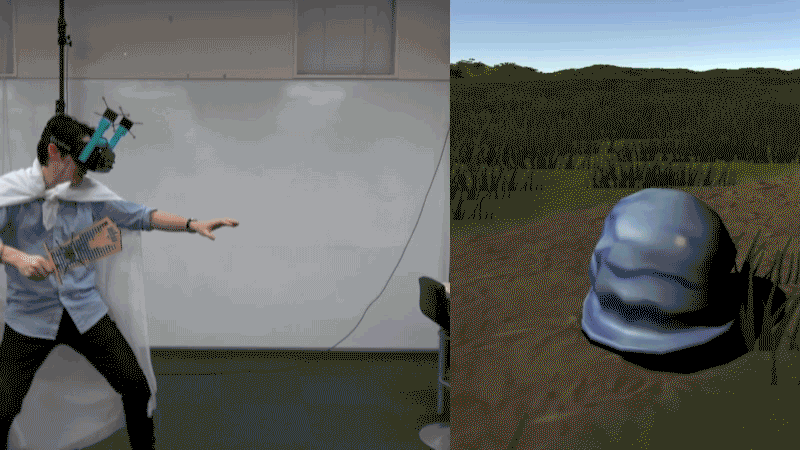
Computational Design of Hand-Held VR Controllers Using Haptic Shape Illusion
†: The University of Tokyo
‡: National Institute of Advanced Industrial Science and Technology (AIST)

†: The University of Tokyo
‡: National Institute of Advanced Industrial Science and Technology (AIST)
We propose a novel method for designing hand-held VR controllers which illusorily represent haptic equivalent of visual shape in VR. Though the actual appearance of the designed controller differs from that of the object in VR, the user perceives as if he handles the object.


Based on the studies in ecological psychology, we assume the existence of a shape perception model, which maps limited mass properties of wielded objects to the perceived shape. We construct the shape perception model and utilize it for computational design criterion of hand-held VR controllers to present appropriate haptic perception.
We build the shape perception model that relates mass properties to haptically perceived shape using a data-driven approach. We aggregate perceived shape data against hand-held VR controllers with different mass properties through perceptual experiments and derive the mapping using regression techniques.


Using the shape perception model, we implement a design system which enables automatic design of hand-held VR controllers whose actual shapes are smaller than target shapes while maintaining their haptic shape perception.. The designed model is easily fabricated through a laser cutter or a 3D printer and can be used as a VR controller.
We design several hand-held VR controllers using our design system to validate our approach. Through a user study using the designed controllers, we verify that controllers designed with our system can present aimed shape perception irrespective of their actual shapes.

Humans are capable of haptically perceiving the shape of an object by simply wielding it, even without seeing it. On the other hand, typical hand-held controllers for virtual reality (VR) applications are pre-designed for general applications, and thus not capable of providing appropriate haptic shape perception when wielding specific virtual objects. Contradiction between haptic and visual shape perception causes a lack of immersion and leads to inappropriate object handling in VR. To solve this problem, we propose a novel method for designing hand-held VR controllers which illusorily represent haptic equivalent of visual shape in VR. In ecological psychology, it has been suggested that the perceived shape can be modeled using the limited mass properties of wielded objects. Based on this suggestion, we built a shape perception model using a data-driven approach; we aggregated data of perceived shapes against various hand-held VR controllers with different mass properties, and derived the model using regression techniques. We implemented a design system which enables automatic design of hand-held VR controllers whose actual shapes are smaller than target shapes while maintaining their haptic shape perception. We verified that controllers designed with our system can present aimed shape perception irrespective of their actual shapes.
Eisuke Fujinawa, Shigeo Yoshida, Yuki Koyama, Takuji Narumi, Tomohiro Tanikawa, and Michitaka Hirose. 2017. Computational Design of Hand-Held VR Controllers Using Haptic Shape Illusion. In Proceedings of the 23rd ACM Symposium on Virtual Reality Software and Technology (VRST '17), pp.28:1–28:10.
DOI: 10.1145/3139131.3139160